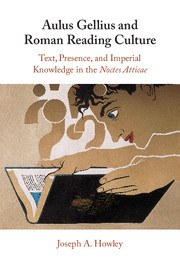 Aulus Gellius and Roman Reading Culture
Aulus Gellius and Roman Reading Culture Book contents
- Aulus Gellius and Roman Reading Culture
- Aulus Gellius and Roman Reading Culture
- Copyright page
- Dedication
- Contents
- Preface
- Introduction
- Chapter 1 How to Read the Noctes Atticae
- Chapter 2 Gellius in the History of Writing about Reading
- Chapter 3 Gellius on Pliny
- Chapter 4 Encounters with Tradition in Gellian Research
- Chapter 5 Favorinus, Fiction, and Dialogue at the Limits of Expertise
- Conclusion
- References
- Index Locorum
- General Index
- References
References
Published online by Cambridge University Press: 23 March 2018
- Aulus Gellius and Roman Reading Culture
- Aulus Gellius and Roman Reading Culture
- Copyright page
- Dedication
- Contents
- Preface
- Introduction
- Chapter 1 How to Read the Noctes Atticae
- Chapter 2 Gellius in the History of Writing about Reading
- Chapter 3 Gellius on Pliny
- Chapter 4 Encounters with Tradition in Gellian Research
- Chapter 5 Favorinus, Fiction, and Dialogue at the Limits of Expertise
- Conclusion
- References
- Index Locorum
- General Index
- References
Summary

- Type
- Chapter
- Information
- Aulus Gellius and Roman Reading CultureText, Presence, and Imperial Knowledge in the<I> Noctes Atticae</I>, pp. 265 - 274Publisher: Cambridge University PressPrint publication year: 2018
